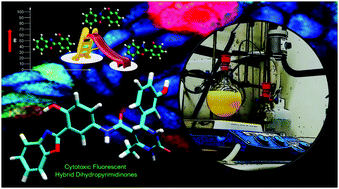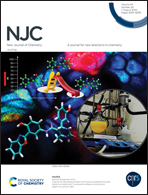Hybrid 3,4-dihydropyrimidin-2-(thi)ones as dual-functional bioactive molecules: fluorescent probes and cytotoxic agents to cancer cells†
Abstract
A series of new hybrid fluorescent Biginelli compounds, including a Monastrol derivative, were designed and synthesized with good yields. The photophysical studies revealed dual fluorescence emission, attributed to excited enol forms (E*) and tautomeric (K*) species, respectively, due to the ESIPT mechanism. The cytotoxic activity of all compounds was evaluated against MCF-7, Caco-2 and PC3 cancer cell lines and PNT2 normal prostate cells. The fluorescent Monastrol derivative 8f was the most active with cytotoxic activity very similar to cisplatin, whereas derivative 8c was the most selective towards the PC3 prostate cancer cells. The confocal laser scanning microscopy images of PC3 and MCF-7 cancer cell lines were acquired after incubation of the fluorescent Biginelli hybrids 8c and 8f, respectively, demonstrating efficient cellular uptake of both compounds and strong fluorescence within the intracellular medium. These results show that the new hybrid 3,4-dihydropyrimidin-2-(thi)ones are dual-function bioactive compounds that act both as fluorescent probes and antineoplastic agents.



 Please wait while we load your content...
Please wait while we load your content...